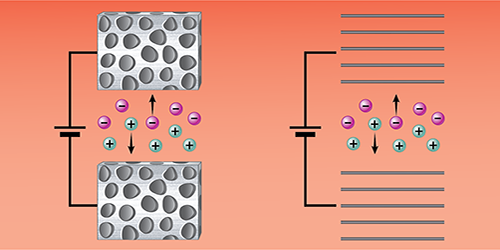Improving Models of How Supercapacitors Charge
Supercapacitors are useful in situations that require bursts of power, such as emergency exit doors of aircraft, because they can store large quantities of electrical charge in relatively small volumes, and they can discharge quickly. But models of the porous electrodes used in these devices underestimate—by several orders of magnitude—the time it takes for them to charge. Now, Cheng Lian of Utrecht University in the Netherlands and colleagues have developed a new model for these electrodes that predicts charging times that are much closer to real values. The result may help researchers design safer and more effective devices for energy storage.
The porous electrodes used in some supercapacitors are sponge-like materials with nanometer-sized pores. This structure means that they pack a huge surface area into a tiny volume—up to a square kilometer in a cube 10 cm to a side. This property lets a supercapacitor store an enormous charge without requiring a large voltage, making it a safe and space-efficient way to store electrical energy. But the large surface area has a downside: it means they take a long time to fully charge. Previous models represented the electrodes either as single-pore structures that failed to capture an electrode’s vast surface area or as single-plate affairs that ignored their porous structures. These simplifications resulted in the models significantly underestimating charging times.
In their new model, Lian and colleagues approximate the porous structure of an electrode with a series of infinitesimally thin parallel plates that are separated by gaps that are the width of a typical pore. Their model predicts charging times that are off by only a factor of 2 or 3 from experimental measurements of real supercapacitors.
This research is published in Physical Review Letters.
–Erika K. Carlson
Erika K. Carlson is a Corresponding Editor for Physics based in Brooklyn, New York.





